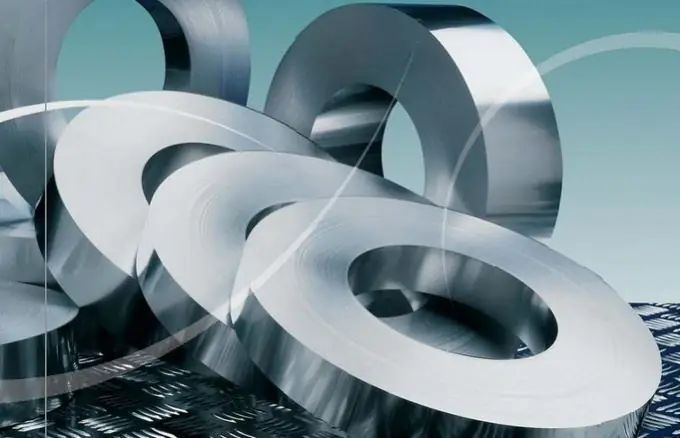- Author Nora Macey [email protected].
- Public 2023-12-16 10:17.
- Last modified 2025-01-23 08:47.
Aluminum and its alloys are widely used in many industries - aviation, metallurgy, nuclear power, electronics, food industry, etc. This metal is liquid in molten form, it fills forms well, in a solid state it is easily deformed and lends itself well to cutting, soldering, welding.

Aluminum is a light silvery metal. It is light, relatively soft, melts at a temperature of 660.4 ° C. Al easily dissolves in strong alkalis, resistant to acids, as a protective film forms on its surface. Finely crushed metal burns in air when heated. The finer its particles, the lower the heating temperature is needed for ignition.
Aluminum is characterized by high thermal and electrical conductivity. This metal is very malleable. This property allows it to be rolled into very thin foil. It also has low strength: pure aluminum can be easily cut with a knife. This metal is very resistant to corrosion - the thinnest film forms on the Al surface, which protects it from destruction.
Depending on the amount of impurities - the purity of the metal - in accordance with GOST, a certain grade is assigned to aluminum.
Duralumin - aluminum alloy
Duralumin was obtained in 1909 in the city of Duren, Germany. The new chemical alloy, named after the city, quickly gained popularity across the planet. The approximate composition of duralumin: 94% aluminum, 4% copper, 0.5% each manganese, magnesium, iron and silicon. The alloy is heated to 500 ° C, then quenched in water and subjected to natural or artificial aging.
The most common aluminum alloy today is duralumin.
After hardening, duralumin acquires special hardness and becomes about seven times stronger than pure aluminum. It, however, remains light - almost three times lighter than iron. The alloy has become much stronger, but has lost one of the most important properties - corrosion resistance. Again I had to use aluminum to combat corrosion. Items made of duralumin began to be clad, i.e. cover with the thinnest layer of pure aluminum.
Aluminum at home
In everyday life, the so-called food grade aluminum is used. According to GOST, food grade aluminum must contain a very small amount of lead, zinc and beryllium impurities. It is also resistant to corrosion, as a dense oxide film forms on its surface. Aluminum is widely used for domestic purposes. Spoons, forks, pots, basins and other utensils are made from it. In tubes they produce toothpaste, sauces, seasonings, canned food.
Why is food grade aluminum so often used for the food industry? This metal is not prone to corrosion, so dishes and kitchen utensils can withstand long exposure to water. When food is stored in contact with this metal, smells and tastes remain unchanged, and vitamins are not destroyed during cooking. Aluminum conducts heat very well, thereby speeding up the cooking process. This metal has sufficient rigidity - it does not deform during the cooking process. Plus, it can be used in ovens and microwaves. Food grade aluminum is an absolutely harmless material for health.
Food foil is also widely used. But foil is thinly rolled aluminum with a thickness of 0.009 to 0.2 mm. This is a great packaging material. In the confectionery industry, biscuits, candy and ice cream are wrapped in it. Foil wrappers are used to pack butter and margarine.
Due to its property of conserving heat, foil is used for storing and transporting food. Moreover, in the process of bending and folding, the integrity of the foil is not violated.
The resulting food packaging has become popular not only because of its strength and flexibility. Aluminum foil is very resistant to external influences: foreign odors, high humidity. It does not interact with either the food itself or its smell, that is, it does not change them.






